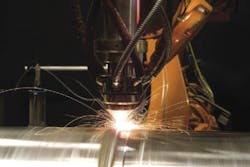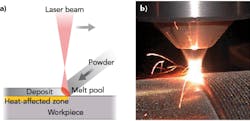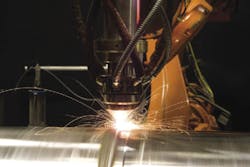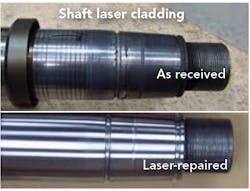Technology enables low-cost refurbishment of high-value components
ROGER KAUFOLD
Society in general is becoming “greener,” and we are witnessing fundamental changes in our attitude and usage of various technologies. Everyone appreciates the benefits of recycling and reusing resources, tools, and gadgets, as long as there is no loss of quality in the end products. From past experience with industrially developed parts of the world and with the ongoing economic difficulties around the globe, we know that we no longer have the luxury of being able to throw away everything that is slightly damaged. Yet the world over, commercial advertisements and marketing tools are pressuring society to buy the latest products. This is how the consumer society was created and is sustained, to the detriment of our natural resources.
Fortunately, cooler heads in society and manufacturing industry understand that we must reduce costs by repairing, regenerating, and renovating. Industry does not have excess money to buy new machines—instead, it needs and really depends on recovery. Even if the resources are available, nobody is now prepared to throw their money to the winds. Thanks to these social changes, new attitudes, and economic pressure, the repair and refurbishment sector of mechanical and manufacturing engineering is currently booming.
The size and potential of this repair and renovation market is enormous in virtually every manufacturing sector, from heavy equipment to welding. The industrial services market is expected to grow at a compound annual growth rate (CAGR) of 5.4% between 2017 and 2023, and would be worth $35.41 billion by 2023.
How laser cladding works
In these industrial processes, an arc is established to melt the surface of the base material to a shallow depth. The clad material is then introduced in either wire or powder form and is also melted by the arc, thereby forming the clad layer. Typically, arc welding techniques deliver a fully welded, metallurgical bond having high strength, good impact properties, and low porosity. However, the high heat input into the part usually melts enough of the substrate to produce a significant amount of mixing of the base material into the clad layer. Such dilution is undesirable because it alters the very properties for which the clad material was selected. Also, the high heat input can cause mechanical distortion, creating the need for further processing after cladding to restore the part’s dimensional accuracy. This thermal stress leads to inferior mechanical quality, surface quality problems such as cracks and porosity, as well as shortening the lifetime of the repaired part. Microelectronics is pursuing the same overarching goal of reducing production costs while simultaneously improving yield and final product quality.
Lasers are powering this trend in many industries because of their ability to perform highly precise, non-contact processing. Cladding, in particular, is a process that achieves these ends. With shifting economic pressure to keep machinery in operation, thereby diminishing the size of our carbon footprint in landfills, the repair and refurbishment sector of production engineering is experiencing a positive surge. With the rapid growth of laser applications and the reduced cost of laser systems, laser material processing is being successfully implemented in automotive, aerospace, shipbuilding and ship repair, oil and gas drilling, and many other industries.
By definition, laser cladding is a method of depositing material by which a powdered or wire feedstock material is melted and consolidated by use of a laser to resurface or fabricate a near-net shape part, such as in additive manufacturing. In many cases, laser cladding technology is being used in the repair and reconditioning of all types of mechanical equipment (FIGURE 1). The most common traditional methods for metal cladding are all variations on the arc process.
FIGURE 1. A schematic of the laser cladding process (a) and a steel roll being resurfaced with high-strength steel (b) are shown.
Using the laser as the heat source offers an attractive alternative to arc welding because the laser can produce the required heating in a highly localized and controlled manner (see “Laser cladding advantages”). By melting very little of the bulk material, laser cladding dramatically reduces dilution in the clad layer, while still producing a true metallurgical bond. Also, the lower heat input avoids part distortion, largely eliminating the need for post-processing. High-power diode lasers are a particularly good match for the needs of high-speed, large-area cladding applications.
Laser cladding advantages
• Best technique for coating any shape to increase lifetime of wearing parts
• Particular dispositions for repairing parts, which is ideal if the mold of the part no longer exists or too long of time is needed for a new fabrication
• Most suited technique for graded material application
• Well adapted for near-net-shape manufacturing
• Low dilution between track and substrate (unlike other welding processes) and strong metallurgical bond
• Low deformation of the substrate and small heat-affected zone (HAZ)
• High cooling rate is greater than or equal to fine microstructure
• Wide material flexibility (metal, ceramic, and even polymer)
• A built part is free of crack and porosity
• Compact technology
• Reduced production time
• Highly satisfactory repair of parts
• Production of a functionally graded part
• Production of smart structures
System developments
Substantive research is now being concentrated on developing automatic laser cladding machines (FIGURE 2). Many of the process parameters must be manually set, such as laser power, laser focal point, substrate velocity, and powder injection rate, and thus require the attention of a specialized technician to ensure proper results. However, many groups are focusing their attention on developing sensors to measure the process online. Such sensors monitor the clad’s geometry height and width of deposited track, metallurgical properties such as the rate of solidification, the final microstructure, and temperature information of both the immediate melt pool and its surrounding areas. With such sensors, control strategies are being designed such that constant observation from a technician is no longer required to produce a final product. Further research has been directed to forward processing, where system parameters are developed around specific metallurgical properties for user-defined applications such as microstructures, internal stresses, dilution-zone gradients, and clad contact angles.
FIGURE 2. A laser-cladding process at work on a truck axle is shown; the process can also be used to repair wind-turbine components, such as damaged or worn shafts.
The clad layer improves performance, as well as lowers cost and the choice of substrate material for a part. This invariably represents a compromise between its bulk and surface properties, as well as its cost. For example, it might be desirable to fabricate an engine crankshaft from a material that is sufficiently flexible so that it doesn’t fracture when exposed to high torsional stress. However, it would also be advantageous if, for example, the bearing surfaces of this crankshaft were very hard so that the part would not wear quickly in use. Cladding is a process that enables independent choice of the bulk and surface properties of a material, therefore avoiding this type of compromise. Specifically, cladding involves the creation of a new surface layer on a substrate having a different composition than the base material. For example, it enables a fabricator to utilize a low-cost material for the bulk of a part, yet still selectively achieve the wear, corrosion, or heat resistance properties of a more expensive alloy. Furthermore, cladding cuts costs in many industries by enabling economical refurbishment of high-value parts, rather than expensive replacement.
The powder used in laser cladding is normally of a metallic nature, and is injected into the system by either coaxial or lateral nozzles. The interaction of the metallic powder stream and the laser causes melting to occur, and is known as the melt pool. This is deposited onto a substrate—moving the substrate allows the melt pool to solidify and thus produces a track of solid metal. This is the most common technique, but some processes involve moving the laser/nozzle assembly over a stationary substrate to produce solidified tracks. The motion of the substrate is guided by a computer-aided design (CAD) system that interpolates solid objects into a set of tracks, therefore producing the desired part at the end of the trajectory.
Research is now being concentrated on developing automatic laser cladding machines. Many of the process parameters must be manually set, such as laser power, laser focal point, substrate velocity, powder injection rate, etc., and thus require the attention of a specialized technician to ensure proper results. However, many groups are focusing their attention on developing sensors to measure the process online. Such sensors monitor the clad’s geometry (height and width of deposited track), metallurgical properties (such as the rate of solidification and, hence, the final microstructure), and temperature information of both the immediate melt pool and its surrounding areas. With such sensors, control strategies are being designed such that constant observation from a technician is no longer required to produce a final product. Further research has been directed to forward-processing, where system parameters are developed around specific metallurgical properties for user-defined applications (such as microstructure, internal stresses, dilution zone gradients, and clad contact angles).
Industry usage examples
There are a wide range of successful applications, including offshore rig shafts and drive components for the energy industry, such as boiler tubes and water wall and wind turbine components (FIGURE 3). Other uses include cutting blades and knives for the agriculture industry; logging equipment for the forestry equipment industry; guides, rollers, and drawing dies for the steel industry; hydraulic shaft treatment, buckets, and augers for the heavy equipment industry; and specialized drilling and extraction component repair for the mining industry. The process is also used in the digital printing machine industry, paper mills, and the plastic film and textile sectors.
FIGURE 3. Wear and corrosion processes need environmentally sustainable engineering practices that reduce energy consumption, dangerous emissions to meet government standards, and material waste.
Laser cladding is deployed in manufacturing and repair industries, basically in three different sectors: surface cladding, repair welding, and generative manufacturing. These technologies have been closely associated with the commercial success of laser build-up welding over the past 15 years. The availability of ever-newer generations of laser beam sources have provided the decisive impetus for this successful development. Components in manufacturing/production equipment are often subject to extreme operating conditions that may include oxidation, high temperature corrosion, thermal fatigue, high compressive stresses, and abrasive wear. These conditions result in accelerated deterioration of the functional surfaces and consequentially a reduction in the service life of the component.
It is therefore part of everyday life that when operating any type of mechanical equipment with moving parts, worn metal components need to be repaired or rebuilt. Repairing the component at a fraction of the cost of a new component will save the user a substantial amount of money. In addition, repair of components to original specification will also reduce to need to keep spares, and can significantly reduce downtime if repairs can be implemented rapidly and in situ.
When a worn part is rebuilt, the potential also exists to repair that component in such a manner that its performance is enhanced, resulting in a longer wear life than a new part. Because of the unique capabilities of laser-based refurbishment, this process will be suitable for the refurbishment of the vast majority of components and, in some cases, even the enhancement of these components. However, components that will benefit the most from the laser cladding refurbishment process are generally high-value components where refurbishment and servicing occurs on a regular basis. Although refurbishment applications using lasers and donor materials for component repair, surface patterning, and strengthening have been under development for decades, laser-based refurbishment is just now gaining widespread industrial and commercial adoption. The reasons for increased adoption are similar to those for the growth in laser welding: the advent of higher-power laser systems with tailored beam profiles, improved parts quality, and longevity.
FIGURE 4. A worn refinery slurry pump is shown.
For example, FIGURE 4 shows a slurry pump that experiences excessive wear, colored in blue and outlined by yellow boundary marks. There are 54 tons of production loss each time a pump is taken out of service for replacement, which equates to a $5400 loss based on $100 per ton. The rebuild cost average is $20,000 per pump performed after 4000 hours, or approximately one year of service. Target improvement for a clad liner is 16,000 hrs., or about two years.
The potential of this technology is massive for improving the reliability for new and used components, with research and government groups around the world continuing to contribute to its growth through research programs, industrial applications, and training students in laser cladding techniques.
One of the most important manufacturing considerations today is life-cycle engineering, where the designer must consider both the implications of the part through its service life and the end-of-life disposal of the part. This means that we must now consider the life-cycle implication of a component in terms of its carbon footprint and the long-term impact of the part on the environment.
With refurbishment, by optimizing the design of a product and manufacturing it with absolute minimum material, it is possible to significantly decrease the weight of parts. However, if that part happens to be an aircraft or automotive components, then the life-cycle carbon footprint of the vehicle will be significantly reduced, as the component part made using laser-assist machining will weigh less, generating a lower fuel burden.
Summary
Laser cladding offers numerous advantages as a repair process, providing complete restoration of a part’s initial quality as well as its overall enhancement, resulting in improved and longer service life. It thus demonstrates sufficient suitability for the refurbishment of a high-value components. Further research must be undertaken in terms of establishing input, process and output parameter coherence, and necessary empirical adjustments that will lead to development of a knowledge-based controller, which is of crucial importance for the in situ refurbishment laser cladding process.
REFERENCES
1. E. Toyserkani, A. Khajepour, and S. F. Corbin, Laser Cladding, CRC Press (Aug. 12, 2004).
2. J. A. Folkes, Surf. Coat. Technol., 63, 65–71(1994).
3. W. M. Steen, “Laser surface treatment—an overview,” Laser Processing: Surface Treatment and Film Deposition, Kluwer Academic Publishers (1996).
4. C. Bremer, “Automated repair and overhaul of aero-engine and industrial gas turbine components,” Proc. ASME, 4725X, GT2005-6819, 841–846 (Jan. 1, 2005).
5. J. Wang, S. Prakash, Y. Joshi, and F. Liou, “Laser aided part repair – a review,” Department of Mechanical Aerospace & Engineering Mechanics University of Missouri – Rolla, Rolla, MO (2002).
6. “Market Analysis & Industry Outlook: Repair & Maintenance,” AnythingResearch (Feb. 2018); see https://goo.gl/sSVxLP.
ROGER KAUFOLD ([email protected]) is a surface/coating engineering consultant with his own company, R. W. Kaufold, LLC, in Pittsburgh, PA.




